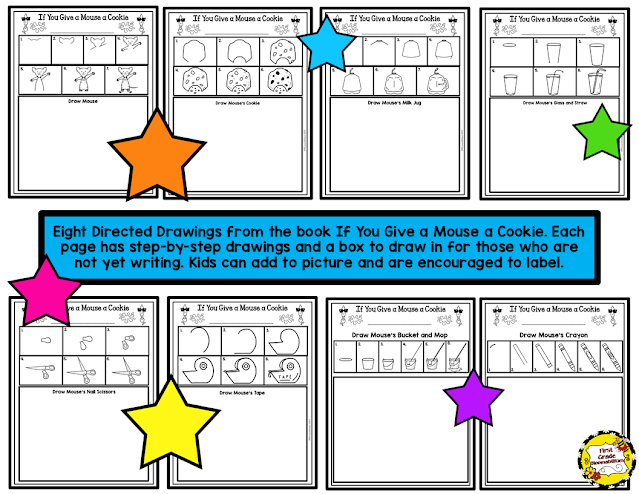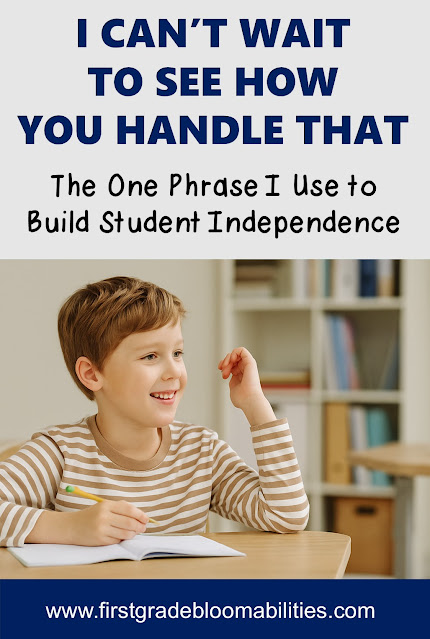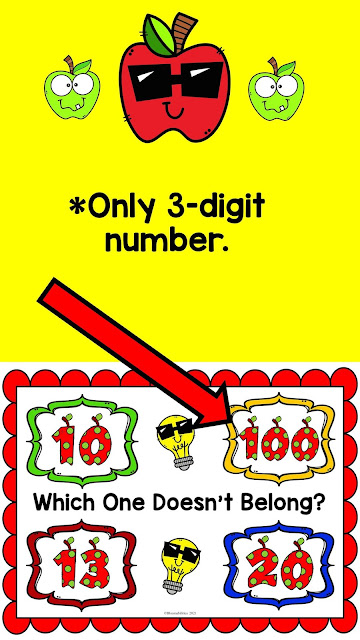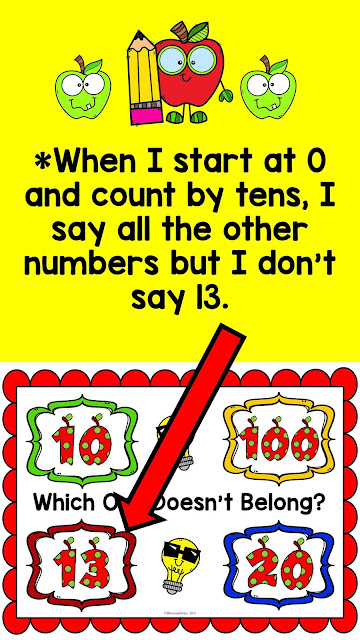Wednesday, July 30, 2025
New Directed Drawing: If You Give a Mouse a Cookie
Tuesday, July 29, 2025
The One Phrase That Turns Students Into Problem Solvers
As elementary teachers, we’re constantly asked to solve problems whether they are big or small. But for the past few years, I’ve been using one simple phrase that has transformed my classroom culture:
“I can’t wait to see how you handle that.”
When a student comes to me with a minor issue like a broken pencil, a missing crayon, or a table partner who is disturbing them, I pause before stepping in. Instead of solving it for them, I hand it back to them with, "I can't wait to see how you handle that."
And guess what? It works. It’s not dismissive. It’s empowering.
This simple line encourages independence, critical thinking, and problem-solving skills which are all essential parts of a growth mindset classroom.
By giving students ownership of small challenges, I’m helping them (my Fabo Firsties!) build confidence and resilience. They start to see that they can handle things on their own and and that their solutions often work. It sends the message: “You’ve got this.” And more often than not, they really do
And over time, I’ve seen real growth. Students start thinking through solutions on their own. They take ownership. They become problem-solvers.
Of course, I’m always there for the big stuff. But for the day-to-day bumps? This one phrase shifts the power back to the kids.
If you’re looking for simple ways to build student independence, promote critical thinking, and strengthen problem-solving skills in your elementary classroom, give this phrase a try. (With lots and lots of modeling/role-playing at first.) It’s a small shift that leads to big growth.

Sunday, July 27, 2025
Why I Keep the Same Bulletin Board Up Every Year (And I’m So Glad I Do)
Confession: I used to stress about bulletin boards. I'd spend way too much time trying to make the layout work, only to realize the board was in a weird, hard-to-reach spot where nothing ever looked quite right. I’d try to divide it. Make it “seasonal.” Rotate displays. It never really worked.
Then I stopped.
A few years ago, I created a board with one simple, powerful message: "The Power of Yet." Bright colors. Big, bold letters. It looked great, and more importantly, it meant something.
At the start of the year, I use it to teach a lesson about growth mindset and the “magical yet.” You can’t read… yet. You don't know how to use a number line… yet. We talk about how our brains grow, and the board becomes a visual reminder of that all year long. I use this book before introducing the board:
And here’s the best part: I leave it up all year. I even leave it up over the summer. (I didn't ask...just did it!)
No more climbing on chairs to staple borders. No more second-guessing a theme. No more back-to-school panic about decorations.
It’s become one of the best classroom decisions I’ve made. Time-saving? Yes. Meaningful? Absolutely. And honestly, the message never gets old.
So if you’ve been thinking about simplifying your bulletin boards, this is your sign. Pick a message that matters—and let it shine all year long.

Thursday, July 24, 2025
My New Favorite PD Hack: EdWeb
If you need PD hours and haven’t checked out EdWeb yet… do it! I just discovered it and I’m honestly impressed. It’s completely free, super easy to navigate, and packed with informative sessions on everything from classroom management to tech tips.
You can watch live or catch the replays, and it even tracks your certificates for you. No stress. Just solid professional learning from the comfort of your couch. 🙌
Here is a screenshot of just a few of the offerings so you get a sense of what they are all about.
I just finished the Webinar Top 3 Techniques for Engaging Math Lessons with High-Quality Instruction.
I did come away with some new ideas to implement and a different perspective on my how I implement my Math Warm-Up session. Nothing crazy earth-shattering but helpful. Reminders. I enjoyed it. Felt like I was listening in on my friends sharing some teaching ideas. Best of all? I felt relaxed. No stress whatsoever. My district requires a lot of PD and I am thrilled to have discovered these high quality Webinars. No more scouring for PD...problem solved!Go peek at edweb.net if you need some hours (or just want fresh ideas). You're welcome! 😉

Tuesday, July 22, 2025
Charleston, I’m Coming for You!
I’m heading to Charleston, South Carolina this November, and I’d love your help! I’m looking for all the can’t-miss eats, treats and sights. Especially anything unique or a little off the beaten path. Got a favorite rooftop bar? A must-try restaurant? A quirky tour or hidden gem? Drop it in the comments or email me.
I’ll be there for 4 days and want to make the most of it. Going with college friends which is the BEST part for sure!

Monday, July 21, 2025
New Directed Drawing (NO, David!) and Growing Bundle
I’m so excited to share my second Directed Drawing Bundle. This is a GROWING BUNDLE and it’s a good one! If you’ve been wanting to bring a little art-meets-literacy magic into your classroom, this is a good time to grab this!
At the moment, this bundle includes two Directed Drawings: No, David! and Piggie and Elephant.
The bundle is just $6 as of now before I add the next Directed Drawing later on this week. That means you get the remaining 3 that will be uploaded within the next few weeks FREE. How cool is that?
What are the next books to be added? Drumroll, please!
1. The Recess Queen
2. Mother Bruce
3. If You Give a Mouse a Cookie
✅ Morning work
✅ Literacy centers
✅ Art integration
✅ Sub plans
✅ Fun Fridays
✅ Early finishers
✅ Read-aloud extensions
✅ Bulletin boards
✅ Fine motor practice
✅ Indoor recess
✅ End-of-day wind down
Each one is easy to follow, super classroom-friendly, and helps students build fine motor skills, creativity, and confidence. 🖍️
Take a peek at my Complete Directed Drawing Bundle #1
Which one is your favorite? I admit to having a soft spot for David!
Happy drawing!

Sunday, July 20, 2025
The One-Minute Summer Emails That Build Lifelong Parent Connections
Every summer, I send out two short, simple emails to my class from the previous year.
They aren't fancy. They aren't long. But they always get replies like:
🧡 “Thank you — that meant a lot.”
📬 “He smiled so big when he saw your name pop up!”
📚 “She will stop by for that hug the first day back!"
✉️ Mid-Summer Check-In (which is now for NJ Teachers):
Hello, Former FABO FIRSTIE!
I hope you’re having an amazing summer! I’ve been thinking about our class and all the wonderful memories we made together. Don’t forget to read a little each day (use your library card!), write a story now and then, and of course — play outside and have FUN! I miss you and I’m so proud of how much you grew this year. 💛 Never forget...YOU ROCK!
✉️ One Week Before School Check-in
Hello, Former FABO FIRSTIE!
Can you believe that in a few short days, you will be a SUPER SECOND GRADER! I'm so excited for you! I'm excited to see you again. Don't forget to stop by the first day for a hug, handshake or a high-five. 💛 You're going to ROCK Second Grade!
✨ WHY THIS WORKS:
-
Parents love it. It feels personal, thoughtful, and intentional.
-
Kids feel seen. That one message reminds them: “My teacher still cares.”
-
It builds your reputation. You’re not just the teacher they had — you become the teacher they remember.
And best of all?
💡 It takes under 1 minute to send each one.
If you send a letter like this to your former students, I’d love to hear how it goes. It’s such a small thing that makes a big difference.

Wednesday, July 9, 2025
Rethinking “Which One Doesn’t Belong?” — Open-Ended Questions for Deep Thinking
If you've ever asked your students “Which one doesn’t belong?” and expected one right answer, it’s time to shake things up! In my classroom, I use open-ended versions of this classic task to spark conversations, build confidence, and encourage flexible thinking.
These aren't your typical multiple-choice worksheets. Each prompt includes four items and every option has a reason it could be the odd one out. Students are asked not just to choose, but to explain their thinking.
Let's take a look at one math-related slide and the possible answers:
Why is this powerful?
✅ It invites deeper thinking. Students look for patterns, exceptions, and relationships.
✅ It values all voices. There’s not just one “right” answer—there are many justifiable answers.
✅ It builds math vocabulary (if a math slide!). Kids naturally start to use words like “greater than,” “even,” “tens place,” or “symmetrical.”
✅ It makes formative assessment easy. You’ll quickly see who’s noticing what—and how they’re reasoning.
How I Use Them in the Classroom
-
✏️ Morning Work or Do-Nows
A great way to get students settled and thinking at the start of the day. 💙Morning Meeting Activity! Truly the perfect activity and it wakes up their brains. A double win!
-
👩🏫 Math or Reading Workshop Warm-Ups
Perfect for mini-lessons or number talks. One slide, one conversation—tons of insight! -
🤝 Partner or Small Group Work
Students explain and debate their choices—collaboration meets critical thinking! -
🧠 Early Finishers or Centers
These tasks feel like puzzles—but sneak in serious learning.
What’s Inside My “Which One Doesn’t Belong?” Resources?
I’ve created grade-friendly sets for first and second grade with:
-
Full-color slides for digital display that come in Google Slides and PowerPoint
-
Printable versions in black and white only. A different format but just as good.
-
A mix of visual and numerical reasoning prompts
-
Open space for writing and drawing to explain thinking
Whether you're building number sense or stretching higher-order thinking, these flexible prompts are easy to plug into your routine.
Ready to Try It? Here's a free sample to get you started.
Which One Doesn't Belong? FREEBIE
I also have two wildly popular Which One Doesn't Belong products and have recently created monthly versions. Get the bundle below for $25 which is $11 off the regular price. That's like getting 3 months FREE! Gotta love that!
I never have to worry about last minute plans or having something READY at a moment's notice. These Which One Doesn't Belong? slides are life-saving for me!

Monday, July 7, 2025
My Favorite Low-Prep Literacy Hack (Especially for Sub Plans!)
Ever feel like your read-aloud just needs something after it’s over?
You know the moment: your class loved the story, everyone’s engaged, and then… crickets. Do we write? Do we draw? Do we move on?
Enter one of my favorite grab-and-go solutions:
Book It: Retell It, Write It, Make It!
These printable mini-packets are the perfect follow-up to your favorite picture books—especially the ones featured on Storyline Online (Yes, the free site where celebrities read books aloud 🙌).
They’re a total lifesaver when:
-
You need something quick but meaningful
-
You're prepping for a sub
-
You want students to practice literacy skills without extra planning
💡 What’s Inside Each Packet?
Each Book It! packet includes:
📚 A Retell-It page (oral and written)
✏️ A Write-It prompt (A story-connected writing activity
🔤 A Make-a-Word phonics page – built around a key word or theme from the book
They’re print-and-go and student-friendly for Grades 1-3!
📚 Which Books Are Included?
So far, the Storyline Online Growing Bundle includes 16 titles:
- Henry Holton Takes the Ice
- The Empty Pot
- Somebody Loves You, Mr. Hatch
- Zombies Don’t Eat Veggies!
- When a Dragon Moves In
- Trombone Shorty
- Strega Nona
- A Bad Case of Stripes
- Maddie’s Fridge
- I’m Not Scared, You’re Scared!
- Enemy Pie
- Chester’s Way
- Jabari Jumps
- Arnie the Doughnut
- Stellaluna
- The Hula-Hoopin’ Queen
New packets are being added every week!
Try One for Free!
Want to see what they’re like?
Grab the free Book It for The Sandwich Swap
It’s perfect for character-building and discussion, too.
💰 Snag the Growing Bundle Now!
The Growing Bundle currently includes 16 packets (a $32 value)
But right now it’s only $12 — just 75¢ each!
And every new addition is included automatically. 🎉
➡️ Storyline Online Book It Growing Bundle
Whether you’re lesson planning at midnight (we’ve all been there) or prepping an emergency sub tub, Book It! packets have your back. Easy, engaging, and done for you. ✅
Let me know if you try one—I love hearing which books your kids connect with most!
✏️ Teacher tip:
Make a few copies, pop them into a plastic sleeve, and store them with a QR code to the read-aloud video. Instant sub plan or early finisher bin!

Sunday, July 6, 2025
Why 120 Chart Puzzles Belong in Your Math Centers
Looking for a low-prep, high-impact math center that builds number sense, encourages perseverance, and keeps kids engaged? Try120 Chart Puzzles Such a small-but-mighty math activity that packs in tons of learning with minimal teacher effort. Very minimal!
✂️ What Are 120 Chart Puzzles?
They’re exactly what they sound like! Take a 120 chart, cut it into pieces, and ask students to reassemble it like a puzzle. You can use a blank 120 chart as a base or let kids build directly on a table or tray.
Just print, laminate if you want, cut, and toss the puzzle pieces into a baggie—and you're DONE. It’s an instant, reusable center that students can work on solo, with a buddy, or in a small group. NOTE: I do not laminate. Instead, I print directly onto construction paper. Sturdy enough. Just use different colors in case pieces wander about. This way, it will be easy to get the piece back into the right baggie.
🧠 What Skills Do 120 Chart Puzzles Build?
These puzzles do more than just keep early finishers busy. They actually strengthen key number concepts, including:
-
Number Sequencing – Kids get constant exposure to counting patterns and one-more/one-less logic.
-
Place Value Understanding – Students see how tens and ones interact as they place pieces.
-
Number Pattern Recognition – Rows go up by 1s, columns by 10s. The more they build, the more these patterns stick.
-
Problem-Solving & Perseverance – Rebuilding a 120 chart isn’t always easy, especially when the pieces are irregular. It encourages stick-to-itiveness!
-
Spatial Reasoning – Students have to rotate and flip pieces to find their correct spot.
-
Math Talk – These are great for partner work and guided math groups. You’ll hear rich conversations like “This number should be right above 54…” or “There’s a 72! That means this piece might go here.”
🧺 Simple to Prep, Easy to Differentiate
The beauty of this activity is that it’s low-maintenance for you and highly adaptable for your learners.
-
✅ Use full puzzles for beginners
-
✅ Cut charts into larger chunks (like rows or columns) for support or K students.
-
✅ Use more complex cuts for early finishers or second graders
-
✅ Offer blank 120 charts or clues to scaffold learners that they can place pieces directly onto.
-
Math Centers
-
Early Finishers
-
Morning Tubs
-
Sub Plans
-
Take-Home Practice
-
Small Group Interventions
-
Partner Challenges
✨ Final Thought
120 Chart Puzzles look simple but they’re loaded with learning. Best of all? Once you’ve prepped them, they’re ready to use all year long. Mine above have lasted a few years so far.
Minimal prep. Maximum impact. That’s a teacher win.

Saturday, July 5, 2025
Why Poetry Belongs in Every Classroom
I got an email on Tuesday asking me why I'm so passionate about using poetry and songs in the classroom. I pulled together my Top 10 reasons why I think using poetry binders in my First Grade classroom is beneficial:
1. Builds Early Literacy Skills
-
Encourages fluency, phonemic awareness, and vocabulary development.
-
Provides repeated exposure to high-frequency words and patterns.
2. Promotes Reading Confidence
-
Poems are often short and rhythmic, making them approachable for young readers.
-
Repetition and predictable structures help build self-assurance.
3. Enhances Listening and Speaking Skills
-
Reciting and performing poems improves oral language skills.
-
Encourages expressive reading and articulation.
4. Supports Memory and Retention
-
Rhyming and rhythm aid memorization.
-
Helps students recall language patterns and content.
5. Encourages Creativity and Imagination
-
Sparks interest in wordplay, imagery, and storytelling.
-
Inspires students to create their own poems.
6. Creates a Personal Reading Resource
-
Students can revisit poems independently, building a sense of ownership.
-
Acts as a growing portfolio of literacy progress throughout the year.
7. Facilitates Cross-Curricular Connections
-
Poems can align with science, social studies, or seasonal themes.
-
Reinforces concepts through engaging language.
8. Strengthens Home-School Connection
-
Students can take binders home to read with family.
-
Encourages literacy outside the classroom.
9. Fosters Classroom Community
-
Shared readings of poetry promote a sense of belonging and shared learning.
-
Class favorites can become part of daily routines or transitions.
10. Supports Differentiated Instruction
-
Binders can be customized with poems suited to individual reading levels or interests.
-
Provides an accessible entry point for struggling or emerging readers.

Thursday, July 3, 2025
Piggie & Elephant to the Rescue! Directed Drawings
If your students are anything like mine, they’re obsessed with Mo Willems. And if you’re anything like me, you’re always on the lookout for activities that check all these boxes:
✅ Engaging
✅ Low prep
✅ Tied to literacy
✅ Actually FUN
Well, friend, consider it done! Let me introduce you to my Piggie & Elephant Directed Drawing Printables — aka: the magical combination of writing, reading, drawing, and "LOOK WHAT I MADE!" moments that will make you feel like a superhero (without the cape or paperwork).
What’s the Deal?
Your students get to follow simple, step-by-step directions to draw Piggie, Elephant, the Big Guy (hi, whale 🐳), Love Birds, a car, and a ship. That’s SIX different drawing options—differentiated FOUR ways—because you teach real humans, not identical robots.
Some pages are no-writing-required (perfect for kinders or “I lost my pencil” days), and some have sentence-writing options with different line types depending on your students' abilities or handwriting stage. There's even extra paper for your little novelists. I see you, future Mo Willemses.
Why Teachers Love This:
-
It’s a sneaky way to reinforce comprehension. (“Let’s draw Gerald! But wait… what’s he feeling in the book again?”)
-
It builds fine motor skills without a single clothespin or play dough in sight.
-
Students become very proud of their creations. Like, “Please display this until I graduate” proud.
-
It’s fun for centers, sub days, Fun Fridays, or “we finished math early and I am NOT starting a new lesson at 2:17 PM.”
Bonus Teacher Tips:
-
Do all six drawings over a week while reading the books aloud = INSTANT cross-curricular magic.
-
End the week by having students combine characters into one scene = hilarious and bulletin board-worthy.
-
Let them record themselves reading their sentences on Seesaw.
-
Keep a binder of reusable directed drawings in sleeves = easy access, forever engagement, zero excuses.
Whether you’re team Piggie, team Elephant, or team “please let the pigeon drive the bus already,” this resource is a go-to gem you’ll use year after year.
Check out the other Directed Drawings I have in action and a full preview of how I format the packet...I think you'll recognize some cool characters your kids will love!













.jpg)



























